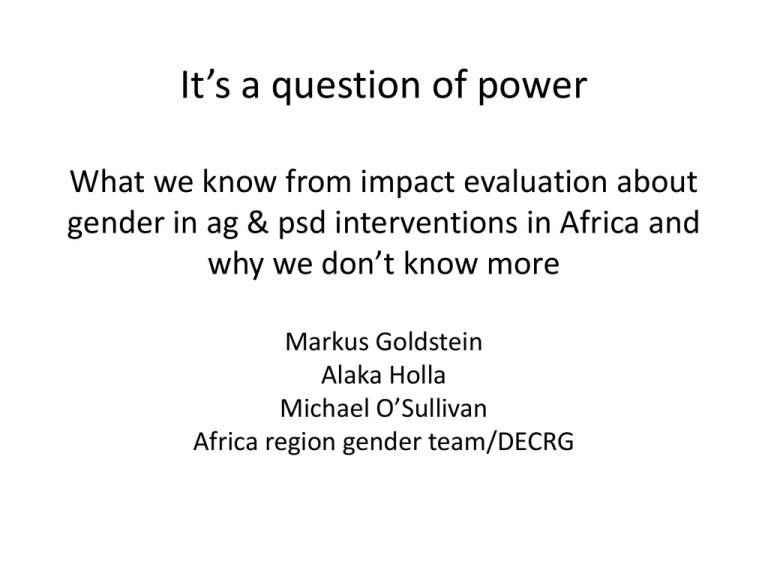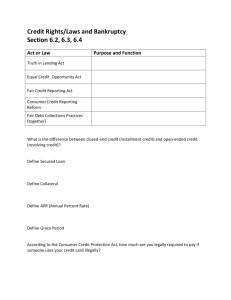It's a question of power
advertisement

It’s a question of power What we know from impact evaluation about gender in ag & psd interventions in Africa and why we don’t know more Markus Goldstein Alaka Holla Michael O’Sullivan Africa region gender team/DECRG How we might think about the gender impacts of policy/interventions A. Male vs female beneficiaries (i.e. who gets the program) B. Spillover benefits: effects on those of different genders w/in the household of the beneficiary (whoever the beneficiary is) C. Differences in male versus female sensitivity/responsiveness to an intervention How we think about our IE results • We are testing the hypothesis: the gender difference is not statistically different from zero • Two ways this can happen: – 1. There might or might not be a gender difference - we can’t tell – the estimates are so noisy as to be indistinguishable NO information for policy – 2. The difference is actually zero (well estimated) policy relevant result We don’t know much • Scattered evaluations • Methods are often improvised ex-post, making it harder to show causal links or they are experiments to test a particular point rather than policy • Agricultural & PSD interventions are harder to evaluate than, e.g. health and education – More data intensive (crop/plot data, firms) – Interventions often multi-sectoral/multi-faceted – For ag: Infrastructure placement does not make finding a control group easy We do know a bit about PSD (although not much) • I’ll discuss some evidence from impact evaluations in small business finance – – – – • Credit: access and take-up Investment and income responses Impacts within the household Suggestive evidence, but not designed for gender effects Know less about – – – – Effectiveness of BDS for women entrepreneurs Effects on enterprise outcomes (by gender) Spillovers to non-enterprise outcomes and total welfare effects What policy interventions can close gaps? Is it desirable to do so? The interventions • Interest free savings accounts in rural banks in Kenya (Dupas & Robinson) • Better information for lenders, and the borrowers know this in Malawi (Gine, et al) • Changing advertising content, interest rates, and extending credit to marginal borrowers in South Africa (Karlan, et al) Savings accounts in Kenya Outcome Credit and borrowing ROSCA contributio ns Income & investment Business investment Household Food expenditure Impact for women Gender difference in impact Smallest detectable difference 18.33 -17.94 |23.23| 252.89 -152.83 |420.97| 24.13 -16.24 |26.24| Numbers in red = statistically significant Fingerprinting borrowers in Malawi Outcome Credit and borrowing Loan size Income & investment Market sales Profits Impact for women Gender difference in impact 309.27 -1253.14 32248.16 -29698.637 97690.57 -98806.78 Numbers in red = statistically significant Smallest detectable difference |1190.32| |39629.29| |96649.46| South Africa: Content of loan advertisements Intervention Outcome Credit and Offered Apply for borrowing interest rates loan Impact for women Gender difference in impact Smallest detectable difference -0.003 0.0002 |0.002| 0.034 -0.039 |0.033| 0.076 -0.020 |0.024| Default Longer deadline to apply Apply for loan Numbers in red = statistically significant South Africa: Extending credit to marginally ineligible applicants Outcome Household Impact for men Gender difference in impact Smallest detectable difference -1.18 1.53 |1.40| Impact for women Impact for men Statistically distinguishable? Have micro loan 0.129 0.119 No Have loan from formal source -0.083 0.008 No Food consumption -0.023 0.232 No Control and outlook 0.159 0.196 No Depression Outcome Credit and borrowing Household And agriculture? Land certification- Ethiopia • Large land certification program, joint ownership for spouses • Reductions in perceived insecurity, big increases in land investment, and increased rental market activity • Gender: Female-headed HHs with certificates were 20% more likely than male headed hh to make soil & water conservation investments in land & spent 72% more time on these investments • (Deininger, Ali, Alemu, 2008) Reducing exposure to risk - Malawi • Rainfall insurance, tied to loans for HYV • Fewer farmers take loan when tied to insurance • Gender: No significant difference • (Giné and Yang 2008) Technological adoption - Kenya • Provided credit, agricultural extension and export facilitation services to farmers to adopt and market export crops • Farmers more likely to grow export crops but no overall impact on farm input usage, HH income or harvest value • Gender: No significant difference • (Ashraf, Giné, and Karlan 2008) Increasing fertilizer use - Kenya • Put in place mechanisms to get farmers to commit to buying fertilizer at harvest rather than later • Small, well-timed discounts can outperform large (not-timed) subsidies • Gender: No significant difference • (Duflo, Kremer and Robinson, 2009) So that’s a lot of insignificant results Why? Unpacking gender insignificance • We are testing the hypothesis: the gender difference is not statistically different from zero • Two ways this can happen: – 1. We can’t tell – the estimates are so noisy as to be indistinguishable NO information for policy – 2. The difference is actually zero (well estimated) policy relevant result What separates the two is statistical power Variable Country 25% detectable impact 50% larger female impact Notes Loan take-up S. Africa 7042 28196 No baseline Loan take-up S. Africa 18046 With baseline & autocorrelation=0.6 4508 Land market participation Ghana Land market participation Ghana No baseline 1112 712 4448 2846 With baseline & autocorrelation=0.6 So where we do we go? • To do this right, to really build the evidence on gender differences, we need bigger surveys, gender incorporated in the design of evaluations • This means: a) that people doing the evaluations pay attention to this (not obvious) b) more money c) The results get used • And thus, it is all a question of power…






